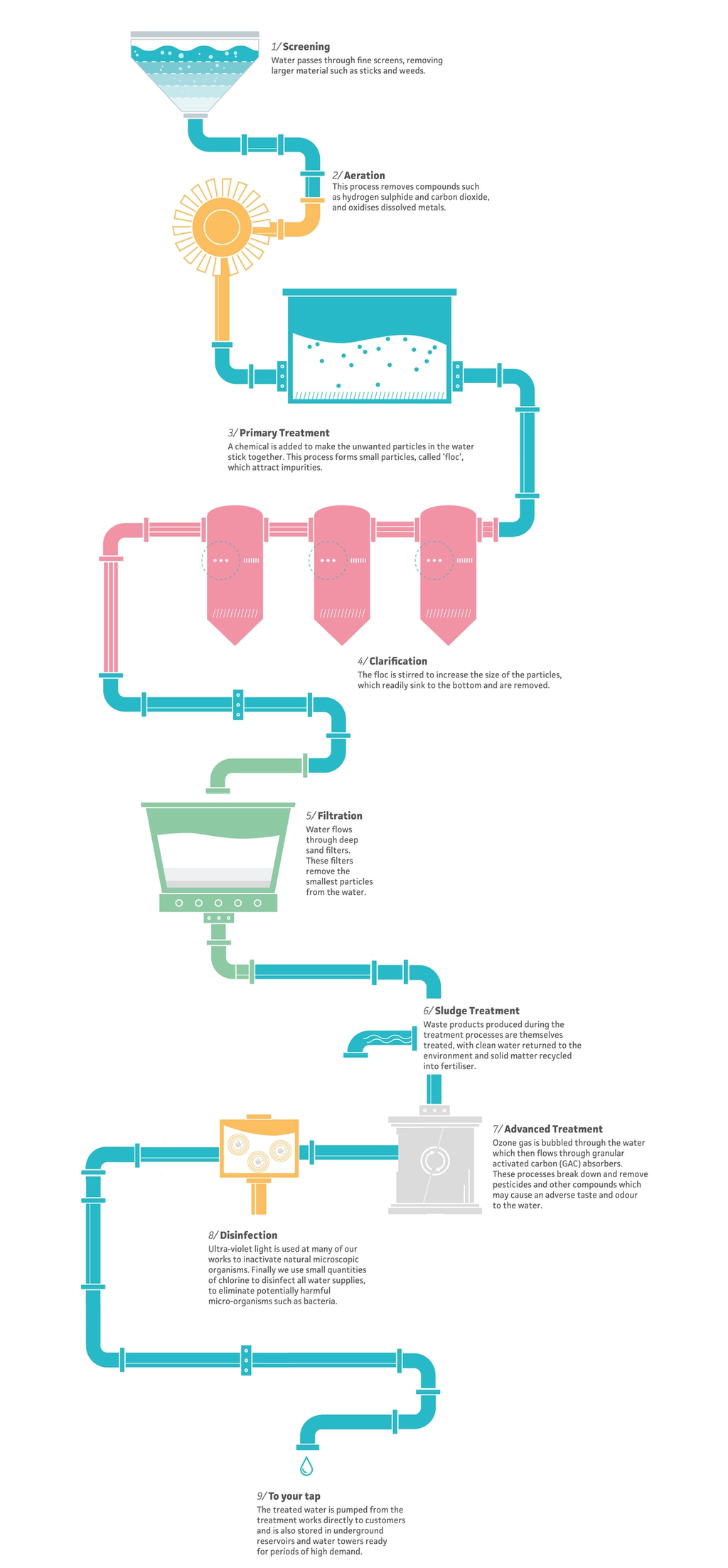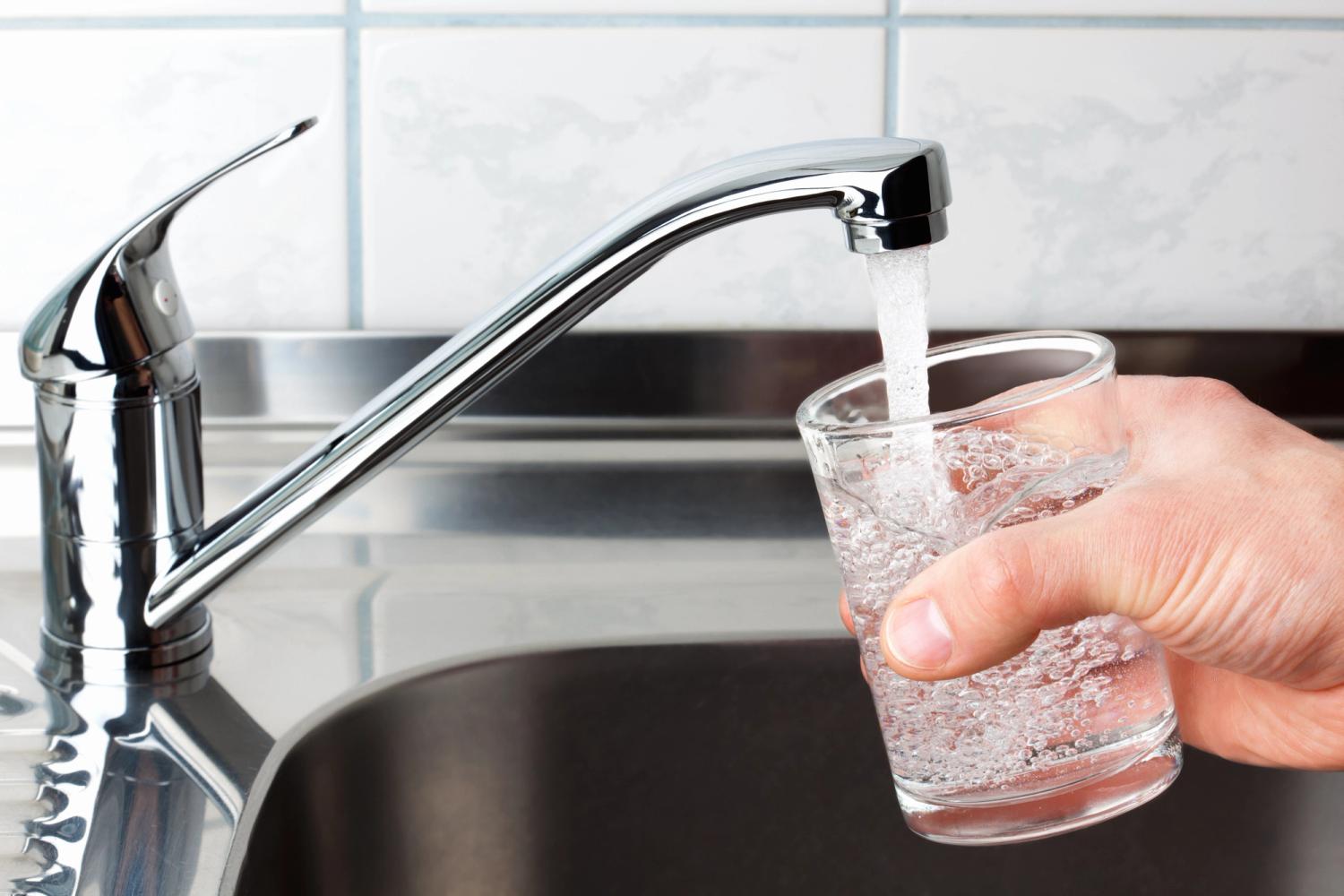Ensuring clean, fresh tap water continues to flow to your taps 24 hours a day, seven days a week, is our top priority.
We treat, pump and supply 530 million litres of water a day to around 2.3 million people.
- 88 water treatment works – that’s how we ensure our water is of the highest quality
- 500,000 water quality tests each year - that’s how we ensure your water meets the highest standards
- 9,000 miles of water mains – that’s how we transfer fresh drinking water direct to your tap
To check the quality of the water we supply in your local area, simply pop your postcode in the box below.
Water hardness search
Water hardness
The hardness of your water depends on the amount of calcium it contains. The higher the levels of calcium, the harder the water.
Water hardness varies from region to region, depending on the amount of minerals which dissolve in rainwater as it soaks through the ground. Most of the water we supply in Southern England comes from underground chalk aquifers, so the water is hard.
This doesn't affect the quality of your drinking water or the performance of soaps and detergents, although it can lead to a build-up of limescale in kettles, boilers and hot water pipes.
Inhibitors, conditioners and softeners
There are a number of products available which either slow down the formation of limescale or actively soften the water. These products work through a combination of chemically slowing down or removing limescale from the mains water.
Softeners can significantly increase sodium levels in water, so if you want to use a water softeners, always make sure that there is a supply of un-softened water coming into your home for drinking purposes.
Rather than interfere with the natural hardness of the region’s water, we leave it up to you to decide whether artificial softening is the right choice.
During its journey to your taps, there are a number of ways in which the appearance of your water may be affected, and occasionally it can become discoloured.
The most common cause of discolouration is a change in the flow or pressure within the pipes – for example as a result of a burst main in your area. The change in pressure can dislodge tiny deposits such as iron or manganese sediments, which may turn the water brown for a short period.
Your water may also appear cloudy, or white, on occasion. If you fill a glass of water and it clears from the bottom upwards then this means your water is just a little more aerated than usual. The bubbles will disappear if the water is left to stand.
In most cases, discoloured water is not harmful and can be cleared by running the cold kitchen tap at a steady flow until it clears. If the water does not clear after 20 minutes, please contact us (https://www.southeastwater.co.uk/help/contact) for advice.
Occasionally, our customers report that their tap water suddenly has an unusual taste or odour. We've set out the most common causes of this below.
Chlorine/TCP/bitter/disinfectant/medicinal
We add small, carefully controlled amounts of chlorine at the treatment works to disinfect the water and a residual is maintained throughout the distribution system to make sure it's safe to drink. Please rest assured that chlorine isn't harmful in the quantities we add and we aim to keep chlorine levels to a minimum.
The chlorine may be more noticeable on some occasions depending on a number of factors, for example: distance from the treatment works, the time it takes the water to travel to your property and the time of day.
If you do have strong TCP tastes or smells from your water, please try the following:
- Check with your neighbour to see if they have same problem
- Make a note of which tap or fitting you were using when the problem started
- If necessary, replace the washer or fittings
- Rinse your kettle out before you use it
- If you suspect your kettle may be causing the taste, try boiling the water in a saucepan and use this water to make your hot drinks
- If you have a washing machine plumbed into the mains in the kitchen, check it has a suitable non-return valve fitted so that water sitting in the hose over long periods is not drawn back
- Musty tastes or earthy smells
- Musty tastes/smells are often caused by water that has been left stagnant after periods of non-use. You can also experience a musty taste when cold water pipes pass near unlagged hot water pipes or radiators where they can become warm. Running your tap for a couple of minutes will bring fresh cold water through
- If you notice this smell or taste for the first time, try using a mild household disinfectant to wash outside and inside your drinking water tap. But don’t forget to let it run a little before you use it again to rinse out the disinfectant
Metallic tastes
A metallic or bitter taste can arise from copper, iron or galvanised pipes that have either not been fitted properly, or may have corroded.
If the water has been standing for several hours in the pipe, fill a washing-up bowl with water to draw fresh water through the pipe. Top tip! The water in the bowl can then be used for watering your garden plants so it's not wasted.
Lead is harmful if excessive levels are allowed to build up in the body, and it is recommended that exposure to lead is minimised. Infants (including unborn babies) and young children are especially vulnerable to the risk of lead, because lead can have an adverse impact on mental development. It is therefore advisable to keep lead levels in drinking water as low as possible.
Our water mains are not made of lead, and there is no lead found in water as it leaves our treatment works. Your drinking water can pick up lead from the pipework that connects the water main to your property. There may be lead pipework inside your property or lead-based solder in the pipe joints.
Lead can dissolve into the water whilst it stands in the pipe. Therefore, if there is lead pipework or lead solder within your property, the chances are there may be lead in your drinking water.
Where a known risk of lead exists, South East Water treats the water with orthophosphate, and this forms a barrier which prevents the lead leaching into the water from the pipework. This reduces the problem significantly. Lead is also less of a problem in hard water areas such as ours because a layer of lime scale builds up between the pipe and the water, preventing the lead dissolving into the drinking water.
How can I tell if I have lead in my property?
If you live in a house built before 1970, you may have lead pipework or lead solder may have been used. It is also possible that you have lead pipes linking your home to our water network. Homes built since 1970, when lead pipes were outlawed for drinking water, tend to have copper or plastic pipes. If pipes in older properties have been replaced since the 1970s, lead pipes will not have been used, but your pipes might still be joined by lead solder if they were installed before 1987.
The Regulations which cover plumbing systems in England no longer allow the use of lead-based solder in domestic hot and cold water systems. It can only be used where the water is not to be consumed, such as the central heating system. There have been cases of lead poisoning due to the illegal use of lead-based solder. Where lead-based solder has been used illegally, all joints must be replaced with lead-free solder. Installers may face a criminal prosecution if they have contravened the Regulations.
If you're concerned that you may have lead plumbing, or would like your drinking water checked for lead, please call us to arrange a visit to your property and we'll take a water sample for analysis, free of charge on 0333 000 0002(opens in a new tab)
Advice to minimise your exposure if you do have lead within your property
Only use water from the kitchen cold tap for drinking and cooking, as hot water dissolves more lead than cold. Do not drink from bathroom taps.
Never cook or mix infant formula using water from the hot tap.
Run the tap for a few minutes before you use the water and make sure you feel the temperature drop before cooking, drinking or brushing your teeth. This is especially important if the water has been standing for a long time in the lead pipes, such as overnight.
Avoid disturbing or knocking lead pipes. Such mechanical action can generate particulate lead.
Do not lay hot water pipes alongside or close to cold water pipes.
Not a drop of water supplied by us has fluoride artificially added.
Does that surprise you? You won't be alone as we've found quite a few customers think we do.
In some parts of the UK, and in other countries around the world, the decision has been made to artificially add fluoride to water supplies because it is considered to have benefits in terms of reducing tooth decay.
This is not the case in our area and we don't ever add fluoride to your water.
Fluoride facts
Fluoride is a naturally occurring substance found in soils and rock. Very low levels can be naturally present in water throughout the country.
Fluoride can greatly help dental health by strengthening the tooth enamel, making it more resistant to tooth decay. It also reduces the amount of acid that the bacteria on your teeth produce.
The quality of your water is of utmost importance to us. The infographic below shows what is involved in treating the water you drink to make it safe.


